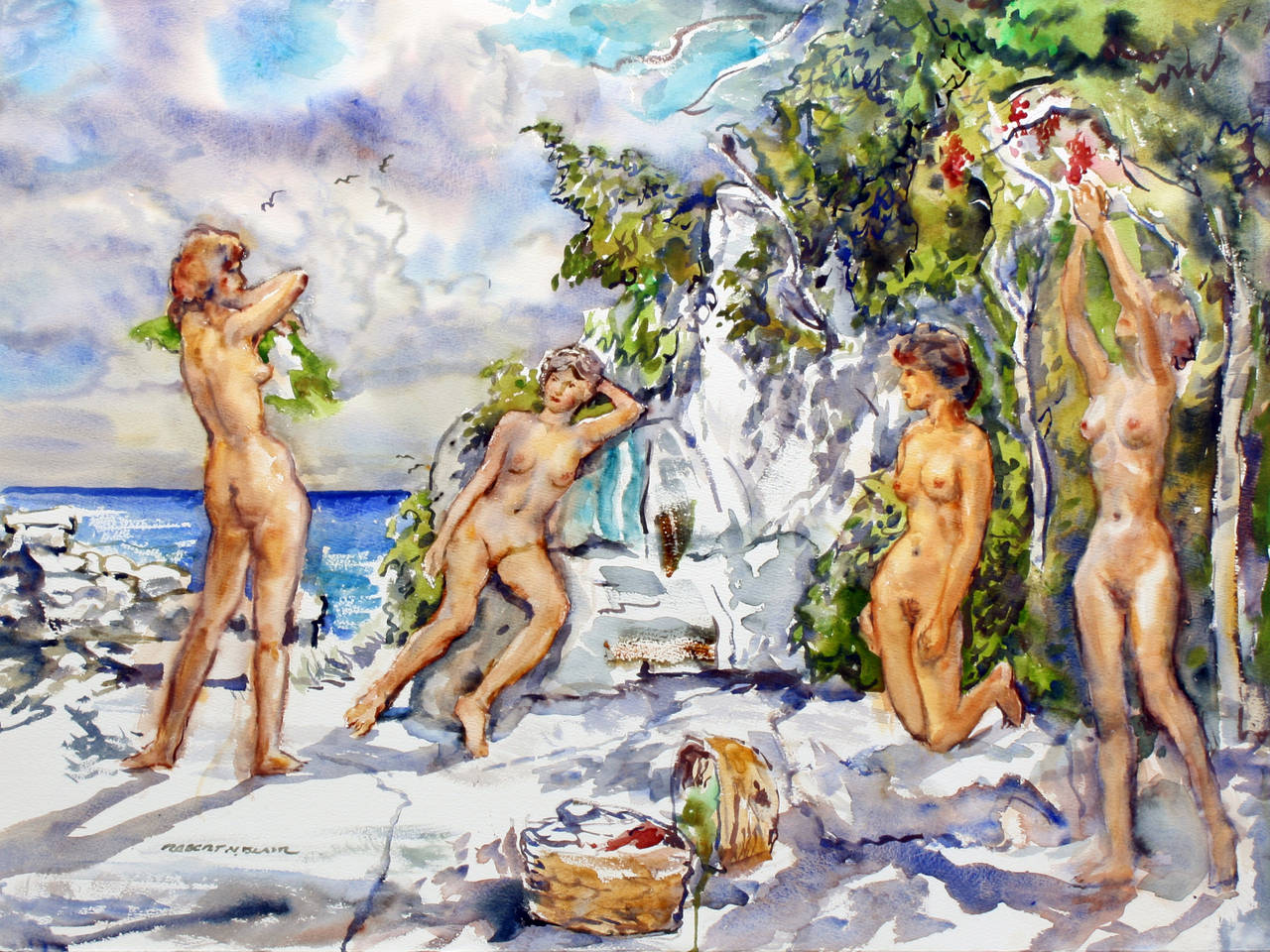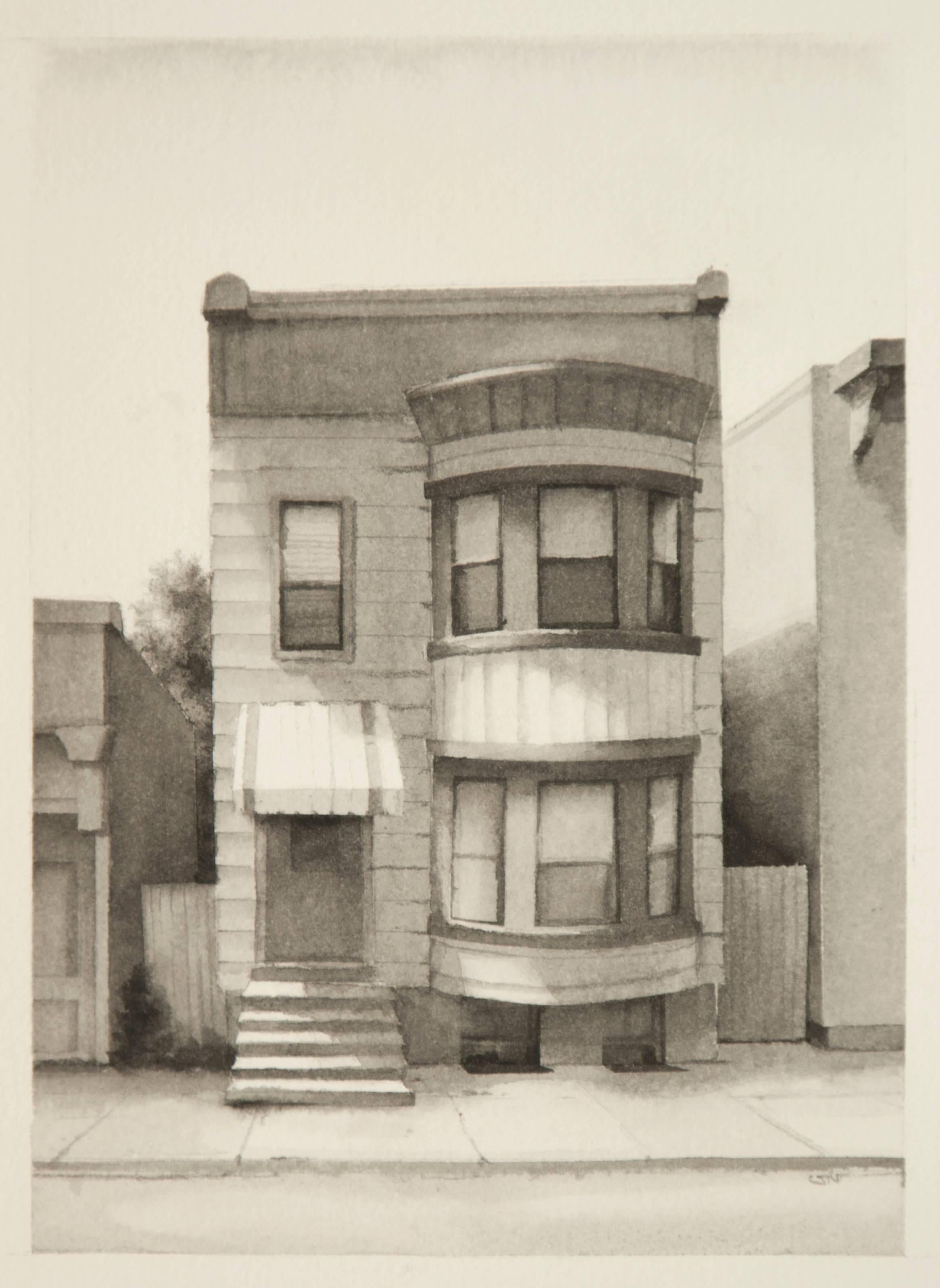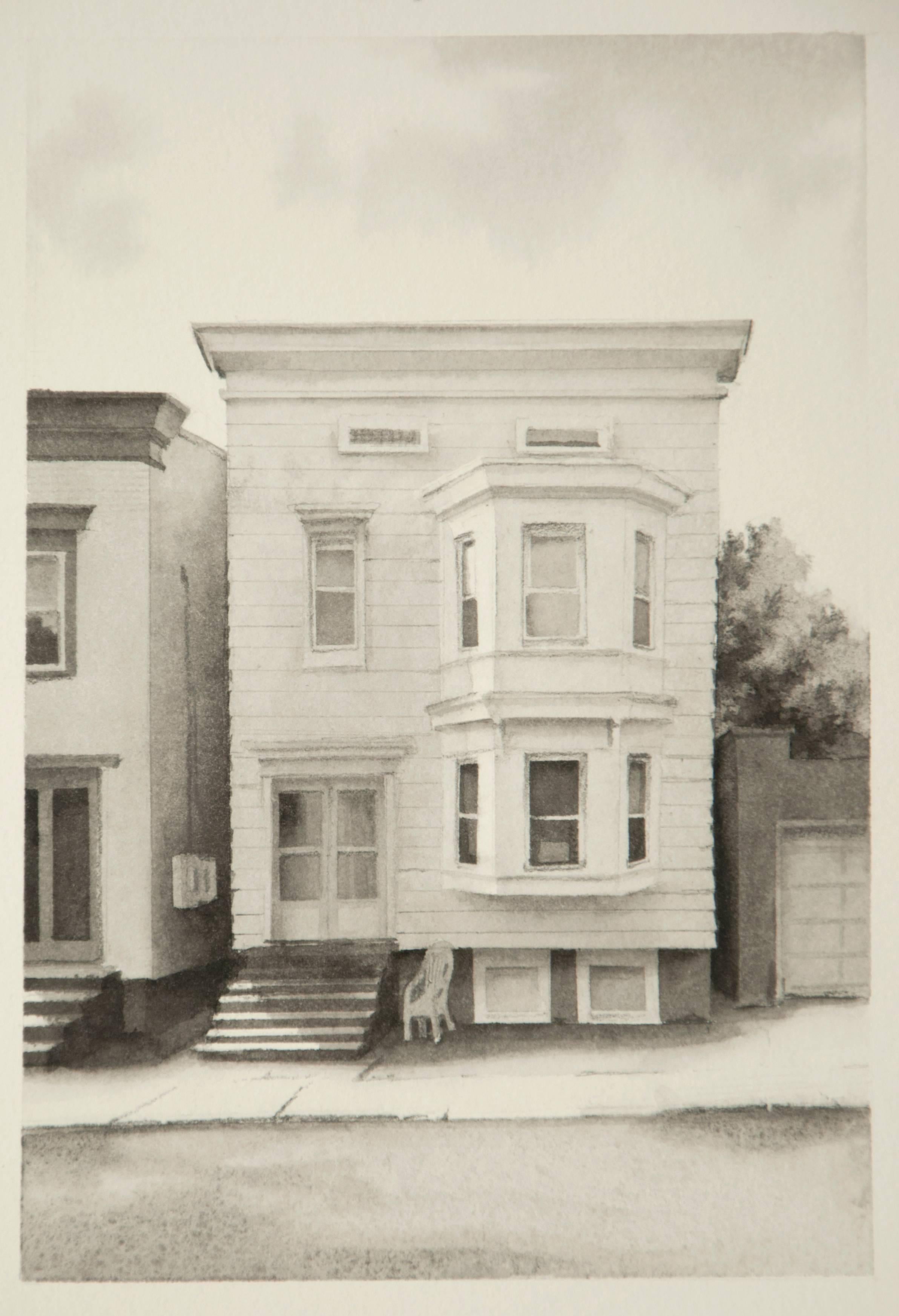Items Similar to “Monhegan Island, Maine”
Want more images or videos?
Request additional images or videos from the seller
1 of 8
Ted Davis“Monhegan Island, Maine”1950
1950
About the Item
Original watercolor of Monhegan Island, Maine on archival paper by the well known American watercolorist, Ted Davis. Signed lower right and dated 1950. Condition is excellent. Child’s Gallery label verso. Overall framed measurements are 14.5 by 17.25 inches. Under glass. Provenance: Childs Gallery, Boston, Massachusetts.
TED DAVIS
Born: New York City, NY 1908
Died: New York City, NY 1995
Louis Theodore "Ted" Davis began his study of art at the Cooper Union Institute in the late 1920s. During the 1930s, he was a student of John J. Newman. Following service in World War II, he used the GI Bill to study art in New York City. In the early 1950s he was a student of Hans Hoffman. From 1948 to 1992 he maintained studios in Manhattan and Monhegan Island, Maine. His work was exhibited in the Annual Exhibitions at the National Society of Painters in Casein, in which he won three awards including Patrons Prize (1957); the Twentieth Biennial International Exhibition at the Brooklyn Museum (1959); and the 29th Annual Mid-year Exhibition at the Butler Institute of American Art (1964). His work was featured in a one-man show at the Farnsworth Art Museum in Rockland, Maine, in 1997, and is illustrated in Monhegan: The Artists' Island (1997). His paintings are featured in collections of the Portland Museum of Art, Portland, ME; the Farnsworth Art Museum, Rockland, ME; the Ogunquit Museum of American Art, Ogunquit, ME; the Olin Arts Center at Bates College, Lewiston, ME; and the Monhegan Museum, Monhegan Island, ME. Davis drew his inspiration from the frenetic energy of New York City where he painted the bustle of the East River, its dock and river traffic. Other favorite urban subjects were musicians, commuters, still lifes, and live models that inspired his lush nudes. For nearly fifty years Davis summered on Monhegan Island; he likened the island to a "big cruise ship." It never went anywhere, but passengers and the atmospherics were constantly changing.
From the late 1940s to the end of his life, Davis' work became increasingly abstract, yet always it contained elements of the natural environment. The early work, influenced by Hans Hoffman's "push-pull theory," used Marinesque brush strokes to imply a setting, rather than utterly define it. Ultimately, these brush strokes resolved themselves into the blocks of color--a fish shack, a boat, and a buoy. From the 1960s to the 1990s he created prismatic layers of thin color, each layer overlapping and intersecting another. Was it the sun that shone through the center of these works? And then, of course, there were Davis' beloved "boids". The gulls of Monhegan ecame his other world, each one imbued with an identity--Reagan, the professor, the shy, and the scolding gull. For a man who lived the routine that Davis followed, the freedom that these gulls possessed fascinated him. Ted Davis was a beloved figure on the island. Many collectors and friends were devoted to his work and through him became educated to the world of modernism. His impromptu lectures on the artists and his insight into art will be remembered for decades. As a painter, his skill was summed up by the painter and The New Yorker cover illustrator, Charles E. Martin, who called him "the best watercolorist on the island!"
- Creator:Ted Davis (1908 - 1995, American)
- Creation Year:1950
- Dimensions:Height: 7 in (17.78 cm)Width: 10 in (25.4 cm)Depth: 1 in (2.54 cm)
- Medium:
- Movement & Style:
- Period:
- Condition:
- Gallery Location:Southampton, NY
- Reference Number:1stDibs: LU14112010692
About the Seller
5.0
Platinum Seller
These expertly vetted sellers are 1stDibs' most experienced sellers and are rated highest by our customers.
Established in 1977
1stDibs seller since 2013
466 sales on 1stDibs
Typical response time: 1 hour
- ShippingRetrieving quote...Ships From: Southampton, NY
- Return PolicyA return for this item may be initiated within 7 days of delivery.
More From This SellerView All
- “Rocky Mountain Meadow”By Werner DrewesLocated in Southampton, NYOriginal watercolor on archival paper of a Rocky Mountain Meadow by the well known American artist, Werner Drewes. Signed lower right. Titled and dated 1956 on verso of sheet. Con...Category
1950s American Modern Landscape Drawings and Watercolors
MaterialsWatercolor, Archival Paper
- “New England Homestead”Located in Southampton, NYVery well executed watercolor on archival paper of a New England homestead nestled in a picturesque valley. Early fall with the tress just starting to change colors. The watercolor was done by the American artist Hilton Leech...Category
1950s Modern Landscape Drawings and Watercolors
MaterialsWatercolor, Archival Paper, Graphite
- “Dutch Harbor”By Anthony Andreas de MeijierLocated in Southampton, NYWatercolor on paper by the Dutch artist, Anthony Andreas Meijiers. Signed lower right. Condition: Excellent. Unframed. Anthony Andreas de Meijiers or Meyer was a Dutch active in...Category
1840s Academic Landscape Drawings and Watercolors
MaterialsArchival Paper, Watercolor
- “End of the Day”By Henry Charles FoxLocated in Southampton, NYWonderful original watercolor of a bucolic scene with a farm with geese and a man on his horse driven wagon as the sun sets in the English countryside. Signed lower left by the British artist, Henry Charles Fox...Category
Early 1900s Post-Impressionist Landscape Drawings and Watercolors
MaterialsWatercolor, Archival Paper
- “The Old Homestead”Located in Southampton, NYOriginal watercolor on archival paper of a rural homestead, most likely in North Smithfield, Rhode Island, home of the artist for 70 years. Signed lower left, “A. Pasquale”. The condition is very good with no issues. Framed in a silvered colored thin metal frame. Overall measurements are 22.25 by 28.25. Under glass. Provenance: Sarasota, Florida estate. Albert Pasquale was a member of the Providence Art...Category
1960s Contemporary Landscape Drawings and Watercolors
MaterialsWatercolor, Archival Paper
- “Smoke House, Duck Cove”By James Milton SessionsLocated in Southampton, NYHere for your consideration is a well executed watercolor and gouache painting on archival paper of a smoke house in Duck Cove, Maine. A flock of white geese are seen in the foreground. Signed lower left. Circa 1955. In excellent original condition. The artwork is housed in a thin custom gold leaf frame and is double mated. Condition of frame is also excellent. Overall framed measurements are 16 by 18.25 inches. James Milton Sessions (born September 20, 1882 in Rome, NY) received his initial exposure to art from his mother, who was an accomplished artist. He trained at the Art Institute of Chicago from 1903–1906 and initially supported himself as a wheelsman aboard Great Lakes ships from 1906–1914, later serving in the Illinois Naval Reserve during World War I. He also worked as a commercial illustrator. He was a master watercolorist of marine, sporting, and military World War II scenes. He developed a love of the sea and is probably best known as a painter of marine subjects. Sessions painted images of numerous locations, from the Bahamas to New England's busy fishing harbors, north to the raw fishing grounds of Nova Scotia, and ultimately to the Navajo reservations in New Mexico. Not only do his works document important World War II historical events, they visually portray and convey the spirit of the American fighting forces in both the Pacific and European campaigns, commencing with the bombing of Pearl Harbor, followed by D-Day Europe through to the final phases of the Pacific war, such as Jimmy Doolittle's daylight bombing raids of the Japanese mainland to the unconditional surrender of the Japanese military. The Chicago Tribune newspaper utilized his talents and Sessions is considered to be the greatest "brush reporter" of World War II. His works can be found in Presidential collections, numerous important corporate collections and military establishments throughout the country. Sessions created numerous wartime advertisements. Examples are a 1943 Willys Jeep ad showing the Coast Guard at Guadalcanal, and a Borg-Warner ad in 1945 showing the mass production of radiators and clutches for motorized warfare manufactured in Detroit. His work is highly collectible in the field of Militaria/WWII/1939-1945. In 1962 the New York Graphic Society commissioned him to make four paintings, reproductions of which were distributed as part of the Society's Works of Masters Group. Many of his other paintings have been reproduced over the years, issued as posters and as high quality reprints on watercolor paper. Sessions was married in Chicago, Illinois in 1946 to Chrysanthy G. Deamanthopulos. Although very prolific in the style of John Whorf and Ogden Pleissner...Category
1950s Post-Impressionist Landscape Drawings and Watercolors
MaterialsWatercolor, Gouache, Archival Paper
You May Also Like
- Nude Picnic Virgin IslandsBy Robert Noel BlairLocated in Buffalo, NYRobert Noel Blair (American, 1912-2003) was an American artist, painter, sculptor, printmaker and teacher. He is best known for his rural life & desert landscapes and World War II sc...Category
1960s American Modern Nude Drawings and Watercolors
MaterialsArchival Paper, Watercolor
- Fourth Street II (Modern Realist Cityscape in Black & White Watercolor)By Scott Nelson FosterLocated in Hudson, NYThis photo-realist cityscape of a residential building in Troy, NY was painted with black and white watercolor by Scott Nelson Foster in 2016. The contemporary cityscape is completed...Category
21st Century and Contemporary Modern Landscape Drawings and Watercolors
MaterialsWatercolor, Archival Paper
- Fourth Street III (Modern Realist Cityscape in Black & White Watercolor)By Scott Nelson FosterLocated in Hudson, NYwatercolor on paper 7 x 5 inches 21 x 17 inches, black stained artist made frame, white mat This photo-realist cityscape of a residential building in Troy, NY was painted with bla...Category
21st Century and Contemporary Modern Landscape Drawings and Watercolors
MaterialsWatercolor, Archival Paper
- Fourth Street IV (Modern Realist Cityscape in Black & White Watercolor)By Scott Nelson FosterLocated in Hudson, NYwatercolor on paper 7 x 5 inches 21 x 17 inches, black stained artist made frame, white mat This photo-realist cityscape of a residential building in Troy, NY was painted with bla...Category
21st Century and Contemporary Modern Landscape Drawings and Watercolors
MaterialsWatercolor, Archival Paper
- Modernist Abstract Expressionist Watercolor Painting Bauhaus Weimar Pawel KontnyBy Pawel KontnyLocated in Surfside, FLAbstract watercolor composition bearing the influence of the earlier color-block compositions of Paul Klee. Pawel August Kontny, (Polish-German-American artist) He was born in Laurahuette, Poland, in 1923, the son of a wealthy pastry shop owner. In 1939 he began studying architecture in Breslau where he was introduced to the European masters and to the work of some of the German Expressionists, soon afterward banned as "degenerate artists" and removed from museums throughout Germany by the Nazi regime. His studies were interrupted by World War II. Drafted into the German army, traveling in many countries as a soldier, he sketched various landscapes but in 1945, he was captured and held as a prisoner of war in Italy. After the war, he studied at the Union of Nuremberg Architects to help design buildings to replace ones destroyed in the war. He recorded his impressions of the local population and the landscapes through his watercolors and drawings. Pawel Kontny thereafter moved to Nuremberg, Germany, becoming a member of the Union of Nuremberg Architects and helping to rebuild the city's historic center. He soon decided to concentrate on his professional art career. He married Irmgard Laurer, a dancer with the Nuremberg Opera. Pavel Kontny 's career as an artist was launched with his participation in an all German exhibition, held at the Dusseldorf Museum in 1952. He held one-man shows in Germany, Switzerland and the United States. During his trip to the United States in 1960, Kontny became instantly enamored with Colorado, and decided to relocate to Cherry Hills with his wife and two children. He quickly established himself in the local art community, being affiliated for a time with Denver Art Galleries and Saks Galleries. His subject matter became the Southwest. During this time he received the Prestigious Gold Medal of the Art Academy of Rome. His extensive travel provided material for the paintings he did using his hallmark marble dust technique. he also worked equally in pastel, watercolor, charcoal and pencil-and-ink. in a style which merged abstraction and realist styles, influenced by Abstract Expressionist painting and South Western American landscapes. This one bears the influence of Sam Francis. In the early 1960s he was one of only a few European-born professional artists in the state, a select group that included Herbert Bayer (1900-1985), a member of the prewar Bauhaus in Weimar and Dessau, Germany, and Roland Detre (1903-2001), a Hungarian modernist painter. As a Denver, Colorado resident, Pavel Kontny exhibited at galleries and museums throughout the United States, Germany and Japan. There, he was inspired by frequent trips to Native American pueblos in the Southwest, as well as by the study of the Plains Indians of Montana and Wyoming. Over the years Kontny had a number of students and generously helped young artist by hosting exhibitions at his Cherry Hills home. For many years he generously donated his paintings to support charitable causes in Denver. Influences during his European years included German pastelist C.O. Muller, German Informel painter Karl Dahmen and Swiss artist, Hans Erni. In the early 1950s his painting style showed the influence of the Die Brücke (The Bridge), a group of German expressionist artists formed in Dresden in 1905 who had a major impact on the evolution of modern art in the twentieth century in Germany. By the middle of the decade his style incorporated more referential abstraction and total abstraction, resulting in part from his study of Hans Hartung, a German artist based in Paris who exhibited his gestural abstract work in Germany. The American moon landing in 1969 inspired Paul Kontny...Category
20th Century American Modern Abstract Drawings and Watercolors
MaterialsWatercolor, Archival Paper
- Modernist Abstract Expressionist Watercolor Painting Bauhaus Weimar Pawel KontnyBy Pawel KontnyLocated in Surfside, FLAbstract watercolor composition bearing the influence of the earlier color-block compositions of Paul Klee. Pawel August Kontny, (Polish-German-American artist) He was born in Laurahuette, Poland, in 1923, the son of a wealthy pastry shop owner. In 1939 he began studying architecture in Breslau where he was introduced to the European masters and to the work of some of the German Expressionists, soon afterward banned as "degenerate artists" and removed from museums throughout Germany by the Nazi regime. His studies were interrupted by World War II. Drafted into the German army, traveling in many countries as a soldier, he sketched various landscapes but in 1945, he was captured and held as a prisoner of war in Italy. After the war, he studied at the Union of Nuremberg Architects to help design buildings to replace ones destroyed in the war. He recorded his impressions of the local population and the landscapes through his watercolors and drawings. Pawel Kontny thereafter moved to Nuremberg, Germany, becoming a member of the Union of Nuremberg Architects and helping to rebuild the city's historic center. He soon decided to concentrate on his professional art career. He married Irmgard Laurer, a dancer with the Nuremberg Opera. Pavel Kontny 's career as an artist was launched with his participation in an all German exhibition, held at the Dusseldorf Museum in 1952. He held one-man shows in Germany, Switzerland and the United States. During his trip to the United States in 1960, Kontny became instantly enamored with Colorado, and decided to relocate to Cherry Hills with his wife and two children. He quickly established himself in the local art community, being affiliated for a time with Denver Art Galleries and Saks Galleries. His subject matter became the Southwest. During this time he received the Prestigious Gold Medal of the Art Academy of Rome. His extensive travel provided material for the paintings he did using his hallmark marble dust technique. he also worked equally in pastel, watercolor, charcoal and pencil-and-ink. in a style which merged abstraction and realist styles, influenced by Abstract Expressionist painting and South Western American landscapes. This one bears the influence of Sam Francis. In the early 1960s he was one of only a few European-born professional artists in the state, a select group that included Herbert Bayer (1900-1985), a member of the prewar Bauhaus in Weimar and Dessau, Germany, and Roland Detre (1903-2001), a Hungarian modernist painter. As a Denver, Colorado resident, Pavel Kontny exhibited at galleries and museums throughout the United States, Germany and Japan. There, he was inspired by frequent trips to Native American pueblos in the Southwest, as well as by the study of the Plains Indians of Montana and Wyoming. Over the years Kontny had a number of students and generously helped young artist by hosting exhibitions at his Cherry Hills home. For many years he generously donated his paintings to support charitable causes in Denver. Influences during his European years included German pastelist C.O. Muller, German Informel painter Karl Dahmen and Swiss artist, Hans Erni. In the early 1950s his painting style showed the influence of the Die Brücke (The Bridge), a group of German expressionist artists formed in Dresden in 1905 who had a major impact on the evolution of modern art in the twentieth century in Germany. By the middle of the decade his style incorporated more referential abstraction and total abstraction, resulting in part from his study of Hans Hartung, a German artist based in Paris who exhibited his gestural abstract work in Germany. The American moon landing in 1969 inspired Paul Kontny...Category
20th Century American Modern Abstract Drawings and Watercolors
MaterialsWatercolor, Archival Paper





